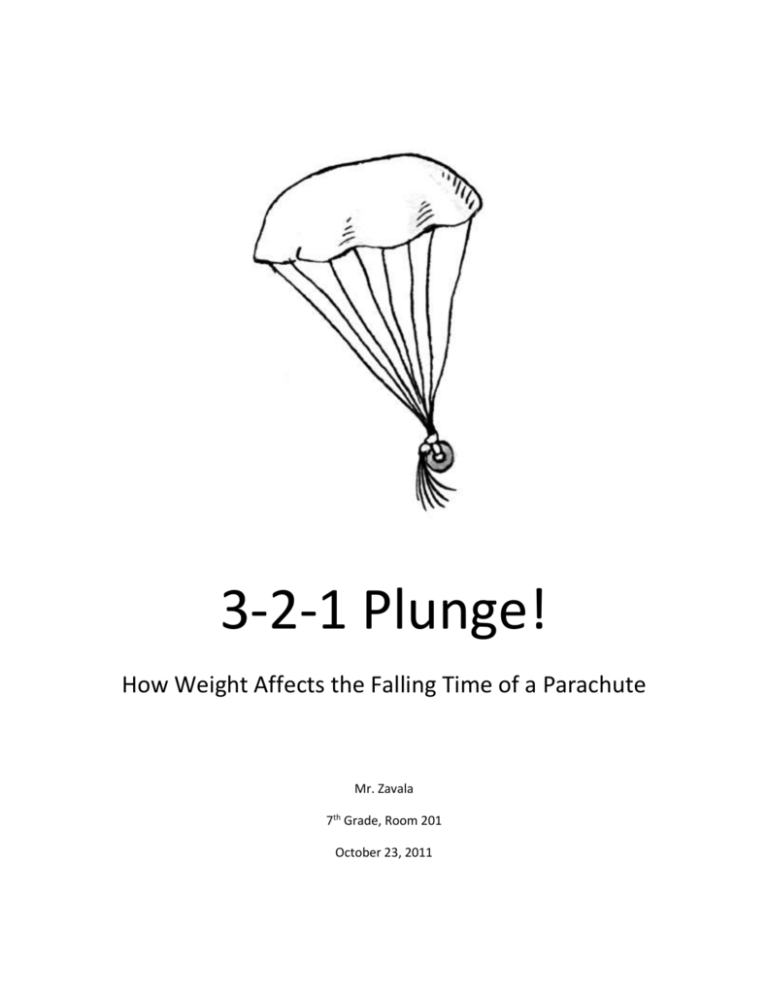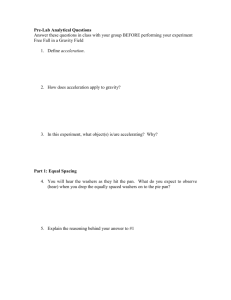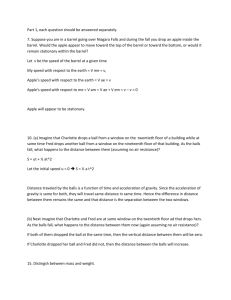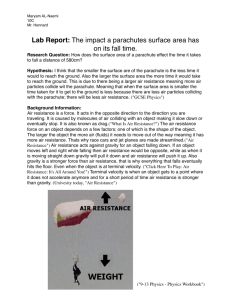Sample Science Fair Paper _Parachute_.doc
advertisement

3-2-1 Plunge! How Weight Affects the Falling Time of a Parachute Mr. Zavala 7th Grade, Room 201 October 23, 2011 Purpose The purpose of the experiment is to see how weight affects the falling time of a parachute when dropped form a controlled height. Hypothesis When the weight attached to the bottom of a parachute increases, I think that the heavier weight will make the parachute fall faster because a greater mass will increase the force pushing down on the parachute. When there is a greater force, this will make the parachute fall faster to the ground. Force = Mass * Acceleration Force= 1g * 9.8m/s2 = 1g/9.8m/s2=0.102N Force= 2g * 9.8m/s2 = 2g/9.8m/s2=0. 204N Force= 3g * 9.8m/s2 = 3g/9.8m/s2=0.306 Materials Fabric Scissors String 3 Washers Meter stick Stopwatch Tape Paper clip Procedure 1. Cut a piece of fabric 30cm x 30cm square. 2. Cut four pieces of sting 15cm long. 3. Make four holes in the corners of the parachute. Secure the four pieces of string with tape at each corner. 4. Gather the four strings at the bottom and tie them in a knot to a paper clip. 5. Measure 3 meters high against a wall. Make a mark with a piece of tape. This will be the drop height for the parachutes. 6. Starting with the parachute (control), drop the parachute. Record the time it takes for the parachute to reach the ground. 7. Complete five trials; then find the average. 8. Add one washer at a time and repeat Steps 6-7. Results Time for a Various Parachutes to Fall (Seconds) Parachute Trial 1 Trial 2 Trial 3 Trial 4 Trial 5 Average 1.6 1.2 1.3 1.4 1.6 1.42 1 washer 1.5 1.1 1.2 1.0 .98 1.16 2 washers .97 .8 1.0 .88 .9 .91 3 washers .75 .79 .7 .66 .65 .71 0 washers (control) Conclusion In this experiment, my hypothesis was supported. This is because as the weight of the washers increased the time it took for the parachute to fall decreased. My hypothesis is supported from the following data. My control, which had 0 washers, had an average fall time of 1.42 seconds over five trials. When I added one washer, the average drop time fell to an average of 1.16 seconds, or 0.26 seconds faster. When two washers were added to the control, the average time to drop three meters was 0.91 seconds, or 0.51 seconds faster than the control, or 0.25 seconds faster than 1 washer. And lastly, the parachute with the most weight (3 washers) went the fastest at an average of 0.71 seconds. This was 0.71 seconds faster than the control! This means that increasing the weight on a parachute decreases the time it takes to fall. I learned a lot from this experiment. Newton’s second law of motion states that Force = Mass * Acceleration. Since gravity stayed constant in this experiment, the only thing that changed was the mass of the washers added to the parachute. This means that as the mass increased, the force acting upon the parachutes would also increase. This explains why heavier parachutes fall faster than lighter parachutes. This also relates to people who go skydiving. I am assuming that people who have more mass are going to have to pull their release string faster than people with less mass since they are going to be falling to the earth faster. If I were to do this again, I would actually try to find out if a relationship exists between drop height and mass. For example, at what height would I have to drop a parachute with 3 washers on it to have the same exact landing time as the control? I got this idea from wanting to skydive. Since I have less mass than my friend, but would want to land on the ground at the same time as her, what heights would we each have to be dropped from to experience our landing time together? I am also curious how the design of the parachute affects how comfortable the descent is. For example, I noticed that the parachutes wobbled back and forth as they were dropped. I wonder how I can make the descent more enjoyable. Photos









